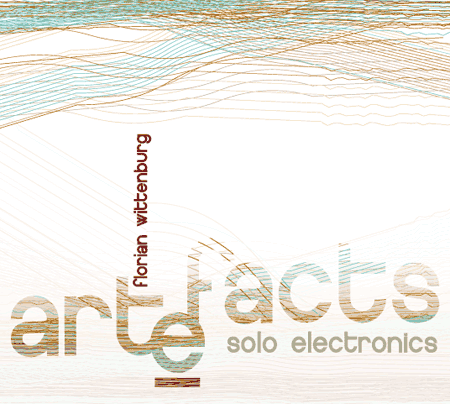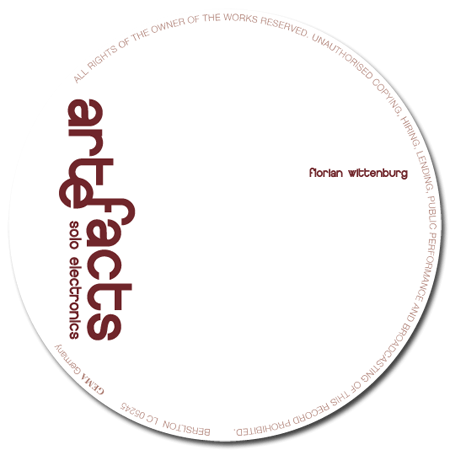
Florian Wittenburg – artefacts
01 Nuageux II (2011) 5:38
02 Chaos baart harmonie (2005) 13:58
03 Noisy knifes + gong (2011) 3:16
04 Aliasing bell pattern (2009) 15:22
05 Nuageux IV (2011) 6:35

Nuageux II, IV (2011)
In composing electronic tracks for the radio play "Weitermalen" (Stephan Froleyks, 2006 Radio Bremen/Deutschlandfunk), I developed a "crisscross-filter", a virtual electronic instrument with which I could improvise. Basically, it allowed me to cross-filter the various sounds of the Messertisch (table knife), a new instrument invented by Froleyks, in real-time. Intrigued by the musicality of what I had done, I decided to improvise some additional tracks and select the best of them for my debut album.
Since my tracks can be thought of as sound-improvisational variations on a theme (the "theme" here being a pre-recorded improvisation by Froleyks, which I use as one of the input signals for the cross-filter), listening to the variations can be compared to viewing a sculpture from different angles. But my sounds also have an indeterministic quality that results from the complexity of my algorithms, which are so complex that I can't predict the results while I'm improvising. This unpredictability, which makes performing all the more interesting, is enhanced by the seeming "mistakes" in the operation of a particular time-stretching algorithm. Moreover, it produces granular artifacts that make the sound even more metallic. But since the overall sound is what I'd call "cloudy", I titled the tracks "Nuageux".
Chaos baart harmonie (2005)
This piece was inspired in part by the ancient greek teaching of the classical four elements: water, earth, air and fire. First the genesis of each of the four elements is illustrated. After each element has been introduced in this manner, they come together and form the quartet of the four elements. Then gradually one spectral partial per element is singled out, hyperbolized. Suddenly a new quartet evolves. If the previous one had been of a rather chaotic nature, this one is rather of a harmonic kind. In this sense a gradual transition from chaos to harmony takes place. As a composer I was intruiged by the idea to first let nature speak for itself, to let it be the composer as much as possible, before I as a human being consciously intervene and shape nature. Mankind, especially western civilization, is doing this all the time - is it to our advantage?
So there is also a transition form nature to culture. And the degree of intervention, of order increases, simply through spectral reduction and shortening the length of the loops, which are first not identifyable as such because they are too long and therefore complex. But as they get shorter patterns arise. And to me a pattern is a symbol of order, rather belonging to culture, though there are patterns in nature too. As with a large gong, which has been hit, at the end only one partial remains and even the last one dies out. For the four elements I convoluted water, earth, air and fire sounds with sounds from the instrument-sculptures made by dutch sculptor Willem Fermont.
Aliasing bell pattern (2009)
Aliasing is a well-kwown term in digital signal processing theory. Simply put, it describes the artifacts that arise when you reduce the sampling frequency, from a standard value like 44,1 kHz. The original signal is then not well represented digitally anymore and mutates. Because you falsefy the original acoustical signal, aliasing is regarded as an artifact, which should be prevented. Basically, it is regarded as a mistake. I have discovered a method with which you can apply this "mistake" in a musical, transformative way. You can hear how a rhythmical pattern mutates gradually, away from its original pattern, until it has finally evolved into a completely different sound-phenomenon – a complex, slow changing drone; from a bell sound it transforms into an organ sound and vice versa. It was my intention to explore the different perceptual qualities of that same algorithm/technique, because 'transitions inbeteween always have the sensation of something phenomenal' (Trevor Wishart). Maybe with this piece I was able to go into this direction.
FLORIAN WITTENBURG – ARTe-Facts
A few years ago I was pleasantly surprised to learn that in our – not too big – town there was somebody involved in experimental and electronic of whom I never heard, Mark Tamea. Now I received another envelope from Nijmegen with music by someone who lives locally but I never heard of: Florian Wittenburg. He works at the Max Planck Institute for Pscyholinguistics, but was born in Berlin, studied in Utrecht, in Paris (at the Centre de Creation Musicale Iannis Xenakis) with Trevor Wishart, Agostino di Scipio and Curtis Roads. He worked with various instrumentalists and sculptors. Perhaps no ties to the local underground, he has them right across the border, as next to Nijmegen lies the smaller German town Kleve, with an active scene of improvised music around the NurNichtNur label. But Wittenburg's own music is not about improvised music. It just finds its original sounds with such crazy inventions as the Messertisch (knives table) instrument by Stephan Froleyks and the Tompret and the Bard instrument sculptures made by Willem Fremont. Wittenburg 'uses the kyma sound design language exclusively for the electronics of all tracks' it says on the cover. Five pieces which could have found its origins in anything really, not just the Messertisch, Tompret and Bard, but whatever Kyma does, it does make things highly unrecognizable. Design wise the cover looks like a serious modern electronic music record and perhaps it is one, yet Wittenburg doesn't play the tricks of acousmatic music which its glissandi and sudden movements. In these five pieces its rather more drone like, but then from a highly digital perspective. All tracks credit Wittenburg with electronics, but 'Noise Knifes + gong' maybe indicate that a gong has been used and that reminded me of the first Thomas Köner record, which this shares a similarity with. Wittenburg's music is actually quite isolationist in approach – although he might not be aware of that, by now, forgotten term. Dark, mysterious rumble, stretched out fields, its all classic isolationist music. Interesting to read that most of these pieces were played live and were improvised with real time processing – which I guess brings him back to NurNichtNur. Quite an interesting and fascinating musical journey and an excellent musical discovery.
Frans de Waard
in Vital Weekly
artefacts solo electronics in: »Neural«, November 2012